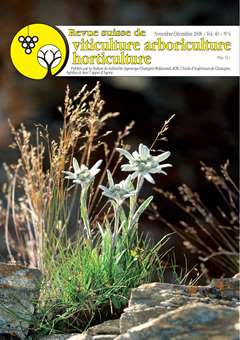
Issue 6 - November - December 2008
Abstract in open access
For the apple grower, the choice of the variety is a very important decision. Price, part of first class apple and yield are key-factors. These factors are different for every variety. The decision of the variety-mix influences the key-factors. The portfolio analysis of market share and rise of market price of the top-ten varieties distinguishes four groups. Every group needs a different strategy. With value-benefit analysis which joins production figures to the evaluation of favoured variety attributes, it was made possible to evaluate which variety achieves the requirements of the producer. Both analyses gave Golden Delicious, Gala and Braeburn as the apple varieties with the best results.
Keywords: apple variety, key-factors, portfolio analysis, valuebenefit analysis.
E-Mail:
Adress: Agora
Abstract in open access
Crop load regulation is necessary in order to achieve an optimal apple quality and a regular production. This regulation is performed using chemical thinning products. Since the beginning of 2008, the new product MaxCel® (benzyladenine or BA) is registred in Switzerland for apple thinning. The aim of this study was to assess the efficiency of this new tool on several apple cultivars. Generally, benzyladenine permitted to thin correctly, but its efficiency was highly dependant on climatic conditions and cultivars. Futhermore, when cultivars or orchards were difficult to thin, it was favourable to mix MaxCel® with Rhodofix® (_-naphthylacetic acid), but the thinning effect could be often excessive when using this mix. Another trial showed that the application could occur when the central fruit presented a size of 7 to 15 mm. This large application window and the availability of a new active substance make it possible to optimize thinning strategies for apples.
Keywords: apple, chemical thinning, benzyladenine.
E-Mail: albert.widmer@agroscope.admin.ch
Adress: Agora
Abstract in open access
Which factors and strategies are effective for profitable apple farming? To answer this question, the Agroscope Changins- Wädenswil Research Station ACW has conducted a representative survey. A specific sample has been drawn concerning organic apple producers. The respondents have evaluated several factors and strategies, which they have implemented in the last ten years, concerning production, inputs, work techniques and cooperation forms. The results for the organic producers show that productivity (kg/ha) is an essential profitability factor,while no statistical relationship has been found between productivity and farm or orchard size. By contrast, the statistical analysis confirms that technical and operational management as well as disposition to innovation are relevant factors, which influence productivity substantially.
Keywords: organic apple production, key factors, strategies, productivity, innovation.
E-Mail:
Adress: Agora
Abstract in open access
Methods determining grape quality and optimal ripeness are more or less complex, long and expensive. Skin texture, and in particular its elasticity, plays very likely an important role in the extractability of phenolic compounds during macerations and therefore on final wine quality. Texture analysis seems then to be important to follow maturity level. This work is based on the analysis of grape texture by both sensory and physical methods, during two vintages. Grapes were weekly picked up on three Cabernet franc parcels having different «terroir» in the Loire Valley. For each date and parcel, a batch of grapes was compressed (texturometry) and another was tasted by trained judges. Results from both methods showed that grape texture evolved during ripening. This change is linked to ripening level and to parcel type (terroir). In 2005, parameters like pressure, work 1 and grad 2 decreased significantly during ripening. In 2006, the most important parameter for maturity assessment was grad1 and for terroir effect the cohesiveness, for both vintages. Sensory analysis discriminated grapes according to their terroir (with nine significant descriptors) and their ripeness level (26 significant descriptors) for both years. Finally, correlations were observed between texture parameters like pressure and sensory descriptors like skin dilacerations.
Keywords: grape maturity, sensorial analysis, texture analysis profile.
E-Mail:
Adress: Agora
Abstract in open access
A multidisciplinary approach aiming at studying the grape-growing areas also referred as «Terroir» was initiated a few years ago in Switzerland. Collaborative studies are carried out on soil characteristics (I. Letessier, bureau Sigales; S.Burgos, Ecole d’ingénieurs deChangins), climatic parameters (Swiss Federal Institute of Technology, Lausanne) and aspects of the plant physiology (Agroscope Changins-Wädenswil ACW). The study of the soil includes the collection of geological and pedological characteristics and viticulturists’ practical knowledge. A large diversity in type and composition of soils was found and highlighted the importance of the parameter of soil water holding capacity (SWHC). In order to evaluate climatic components of the «Terroir», a model was built resulting in a climatic index including temperature, radiation and wind protection. Agronomical studies revealed a good correlation between plant physiology (water status, vegetative growth, sugar accumulation in berries) and water content present in the soil (SWHC). Current studies aim at determining the influence of pedoclimatic factors on the quality of the final product in wine-growing areas in Switzerland.
Keywords: terroirs, soils, climate, ecophysiology, grape quality.
E-Mail: vivian.zufferey@agroscope.admin.ch
Adress: Agroscope, 1009 Pully

 Download of full issue
Download of full issue
 Download article
Download article